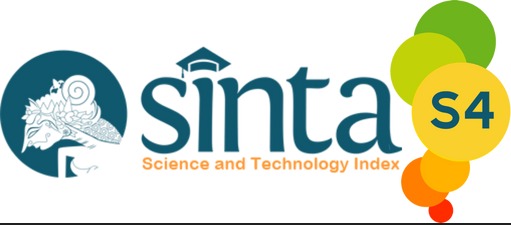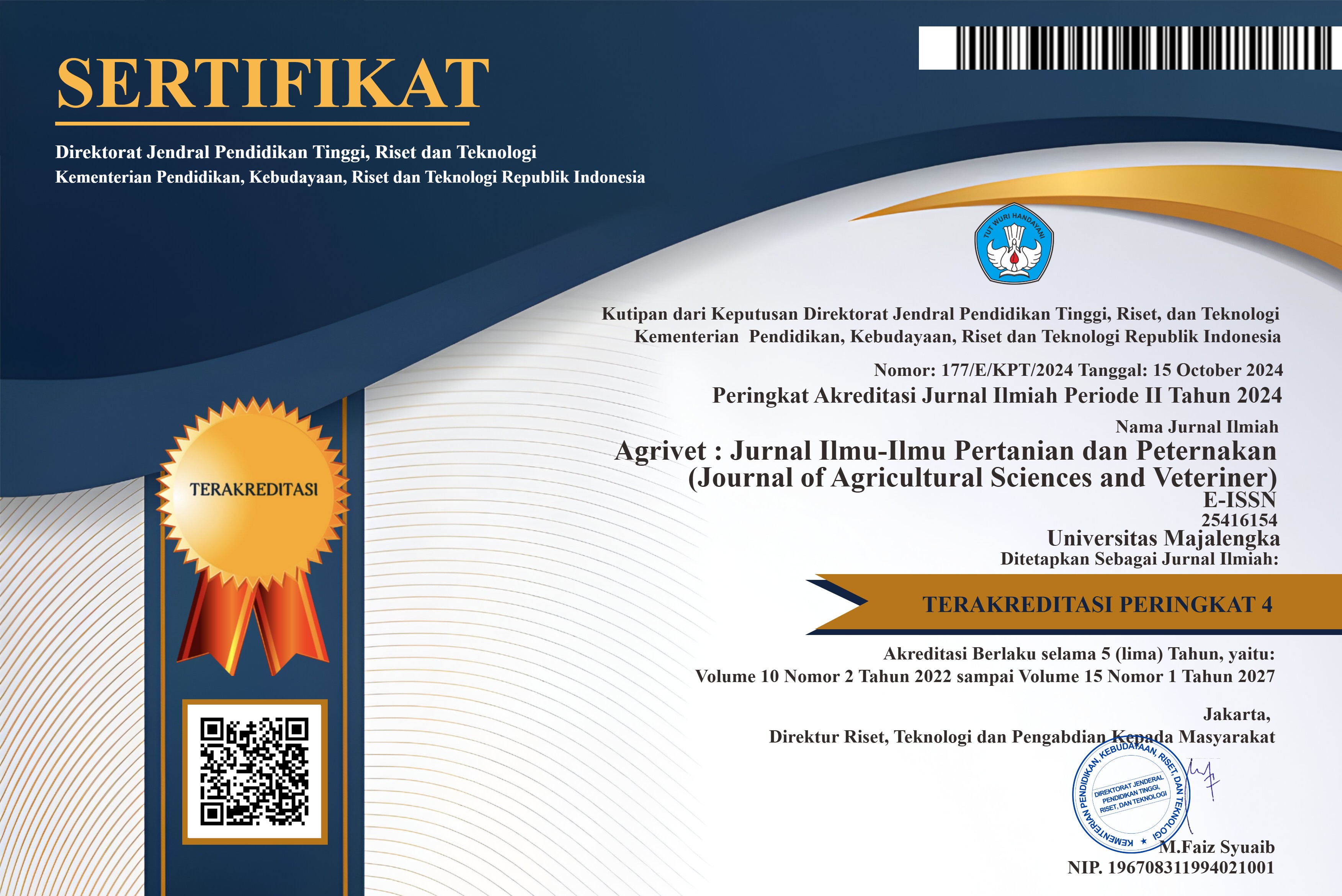Respon penggunaan bakteri penambat nitrogen Rhizobium sp dan pupuk kohe ayam
DOI:
https://doi.org/10.31949/agrivet.v11i2.7486Abstract
This study aims to determine the effect of Nitrogen-inhibiting bacteria and chicken manure (cohe) fertilizer on soybean yield. The research method used a 2 factorial Randomized Group Design. The first factor was the treatment of rhizobium biofertilizer (R) consisting of 4 levels, namely R0 = 0 g/kg seed, R1 = 5 g/kg seed, R2 = 10 g/kg seed, and R3 = 15 g/kg seed. The second factor is the treatment of chicken cohe fertilizer (S) consisting of 4 levels, namely S0 = 0 kg/m2, S1 = 0.5 kg/m2, S2 = 1.0 kg/m2, and S3 = 1.5 kg/m2. The results showed that the provision of rhizobium biofertilizer 10 g/kg seed had a real effect on the number of soybean pods, dry weight of seeds per plant, dry weight of 100 seeds, with the highest number of pods 1169.03 g, the highest dry weight of seeds 388.56 g, the highest weight of 100 seeds 15.88 g. Application of chicken cohe fertilizer 1.5 kg/m2 on the soil had a real effect on the number of pods, dry weight of seeds per plant, dry weight of 100 seeds, with the highest number of pods 167.25 g, dry weight of seeds 393.86 g and the highest weight of 100 seeds 16.50 g. The interaction of rhizobium biofertilizer and chicken cohe fertilizer was not significantly different in all treatments.
Keywords:
Soybean, Nitrogen, Rhizobium, Chicken Cohe FertilizerDownloads
References
Alridiwirsah, A. (2010). Respon Pertumbuhan Dan Produksi Semangka Terhadap Pupuk Kandang Dan Mulsa Cangkang Telur. AGRIUM: Jurnal Ilmu Pertanian, 16(2), 61–70.
Balittanah. (2014). Inovasi Teknologi Pengelolaan Lahan Sawah dan Lahan Kering Berkelanjutan. Laporan Tahunan 2013.
Fitriana, D. A., Islami, T., & Sugito, Y. (2015). Pengaruh dosis Rhizobium serta macam pupuk kandang terhadap pertumbuhan dan hasil tanaman kacang tanah (Arachis hypogaea L.) varietas kancil. Brawijaya University.
Hanifah. (2012). Penggunaan Pupuk Organik Secara Efektif dan Efisien. Penebar Swadaya Informasi Dunia Pertanian.
Harsono, A., Prihastuti, P., & Subandi, S. (2018). Efektivitas Multi-isolat Rhizobium dalam Pengembangan Kedelai di Lahan Kering Masam.
Hartatik, W., Husnain, H., & Widowati, L. R. (2015). Peranan pupuk organik dalam peningkatan produktivitas tanah dan tanaman.
Kanchana, P., Santha, M. L., & Raja, K. D. (2016). A review on Glycine max (L.) Merr.(soybean). World J. Pharm. Pharm. Sci, 5(1), 356–371.
Madigan, T., Martinko, M., & Parker, J. (2002). Biology of Microorganisms, 10th Edition. Pearson Education Inc.
Man, A. (2022). Harga Kedelai Impor Naik, Pemerintah Diminta segera Intervensi. Berita DPR RI.
Marlina, N., Aminah, R. I. S., & Setel, L. R. (2015). Aplikasi pupuk kandang kotoran ayam pada tanaman kacang tanah (Arachis hypogeae L.). Biosaintifika: Journal of Biology & Biology Education, 7(2).
Ramadhani, Anggi, D., & Sumanjaya, R. (2012). Analisis Faktor-Faktor Yang Mempengaruhi Ketersediaan Kedelai Di Indonesia. Jurnal Ekonomi Dan Keuangan, 2(3)(131–145).
Sajar, S. (2022). Pengaruh Aplikasi Pupuk Kandang Ayam dan Cangkang Telur Terhadap Sifat Kimia Tanah, Pertumbuhan dan Hasil Tanaman Kedelai (Glycine max L. Merril). AGRIUM: Jurnal Ilmu Pertanian, 25(2), 95–106.
Sari, E. F., Puspitorini, P., & Kurniastuti, T. (2016). PENGARUH PEMBERIAN LEGIN DAN PUPUK UREA TERHADAP PERTUMBUHAN DAN HASIL TANAMAN KEDELAI (Glycine max (L.) Merril). VIABEL: Jurnal Ilmiah Ilmu-Ilmu Pertanian, 10(1), 20–36.
Sari, R., & Prayudyaningsih, R. (2015). Rhizobium: pemanfaatannya sebagai bakteri penambat nitrogen. Buletin Eboni, 12(1), 51–64.
Sitanggang, A., Islan, I., & Saputra, S. I. (2015). Pengaruh pemberian pupuk kandang ayam dan zat pengatur tumbuh giberelin terhadap pertumbuhan bibit kopi arabika (Coffea arabica L.). Riau University.
Suharjo, U. K. J. (2001). Efektivitas nodulasi Rhizobium japonicum pada kedelai yang tumbuh di tanah sisa inokulasi dan tanah dengan inokulasi tambahan. Jurnal Ilmu-Ilmu Pertanian Indonesia, 3(1), 31–35.
Surtiningsih, T., & Nurhariyati, T. (2009). biofertilisAsi bAkteri rhizobium pAdA tAnAmAn kedelAi (Glycine Max (l) merr.). Berkala Penelitian Hayati, 15(1), 31–35.
Tufaila, M., Laksana, D. D., & Alam, S. (2014). Aplikasi kompos kotoran ayam untuk meningkatkan hasil tanaman mentimun (Cucumis sativus L.) di tanah masam. Jurnal Agroteknos, 4(2), 244107.
Widaningsih, R. (2016). Outlook komoditas pertanian tanaman pangan ubi kayu. Pusat Data Dan Sistem Informasi Pertanian: Kementerian Pertanian, Jakarta.
Yuliana, Y., Rahmadani, E., & Permanasari, I. (2015). Aplikasi pupuk kandang sapi dan ayam terhadap pertumbuhan dan hasil tanaman jahe (Zingiber officinale Rosc.) di media gambut. Jurnal Agroteknologi, 5(2), 37–42.
Published
How to Cite
Issue
Section
License
Copyright (c) 2023 Suryani Sajar, Andi Setiawan

This work is licensed under a Creative Commons Attribution-ShareAlike 4.0 International License.
An author who publishes in the Jurnal Agrivet agrees to the following terms:
- Author retains the copyright and grants the journal the right of first publication of the work simultaneously licensed under the Creative Commons Attribution-ShareAlike 4.0 License that allows others to share the work with an acknowledgment of the work's authorship and initial publication in this journal
- The author is able to enter into separate, additional contractual arrangements for the non-exclusive distribution of the journal's published version of the work (e.g., post it to an institutional repository or publish it in a book) with the acknowledgment of its initial publication in this journal.
- The author is permitted and encouraged to post his/her work online (e.g., in institutional repositories or on their website) prior to and during the submission process, as it can lead to productive exchanges, as well as earlier and greater citation of the published work












